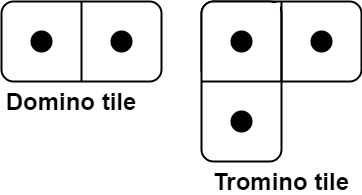You have two types of tiles: a 2 x 1 domino shape and a tromino shape. You may rotate these shapes.
Given an integer n, return the number of ways to tile an 2 x n board. Since the answer may be very large, return it modulo 109 + 7.
In a tiling, every square must be covered by a tile. Two tilings are different if and only if there are two 4-directionally adjacent cells on the board such that exactly one of the tilings has both squares occupied by a tile.
Input: n = 3 Output: 5 Explanation: The five different ways are show above.
Input: n = 1 Output: 1
1 <= n <= 1000
impl Solution {
pub fn num_tilings(n: i32) -> i32 {
if n == 1 {
return 1;
}
let mut dp = vec![(0, 0, 0); n as usize];
dp[0].0 = 1;
dp[1] = (1, 1, 1);
for i in 0..n as usize - 1 {
dp[i + 1].0 = (dp[i].0 + dp[i + 1].0) % 1_000_000_007;
dp[i + 1].0 = (dp[i].1 + dp[i + 1].0) % 1_000_000_007;
dp[i + 1].0 = (dp[i].2 + dp[i + 1].0) % 1_000_000_007;
dp[i + 1].1 = (dp[i].2 + dp[i + 1].1) % 1_000_000_007;
dp[i + 1].2 = (dp[i].1 + dp[i + 1].2) % 1_000_000_007;
if i + 2 < n as usize {
dp[i + 2].0 = (dp[i].0 + dp[i + 2].0) % 1_000_000_007;
dp[i + 2].1 = (dp[i].0 + dp[i + 2].1) % 1_000_000_007;
dp[i + 2].2 = (dp[i].0 + dp[i + 2].2) % 1_000_000_007;
}
}
dp[n as usize - 1].0
}
}
